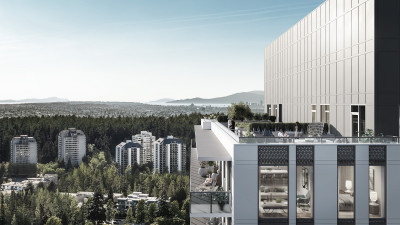Condominiums continue to pop up all over the Lower Mainland and the reasons behind their popularity are not a mystery. Residents get to enjoy being in the heart of a community — often close to public transit — a largely home-maintenance-free lifestyle, and built-in amenities like a gym, swimming pool and in some newer developments, even a basketball court.
However, those looking to purchase a pre-construction unit and who are new to condo living may not be familiar with having to pay a monthly strata fee. We spoke to Fiona Therrien, managing broker and executive vice president of Tribe Management to help demystify the topic.
What are strata fees?
This is a monthly fee paid to the building’s Strata Corporation to pay for the common expenses of the development or building.
“Some Common Expenses that maintain the buildings are: building insurance, management fees, landscaping, waste collection, utilities and administrative costs.” explains Therrien when asked where exactly the funds go. “As well as less frequent or perhaps unusual expenses that occur such as lobby upgrades, new roofs, new gutters, or sidewalk fixes.”
To determine the specific figure each owner pays, the strata corporation’s total expenses are divided by the unit entitlement (share of common property and assets belonging to each strata lot), based on the livable size of the lot. In other words, homes with a larger footprint are more expensive.
CRF and operating fund
While regularly occurring and forecasted expenses would typically be paid out of an established, and routinely maintained, operating fund managed by the strata corporation, a contingency reserve fund (CRF) is earmarked to address those bigger, more irregular projects. For example, repairing the roof or upgrading common area flooring.
It is important to note that strata fees often change during or after the one-year mark of a new building being occupied. Pre-sale strata fees go towards an interim budget meant for the first year or so of occupancy, at which time it is often reassessed, based on building occupancy and longer-term considerations around wear-and-tear or regular maintenance items, that may not have been factored in.
Therrien adds the CRF must equal 25 per cent of the annual operating fund budget, otherwise the Strata Corporation is required to continually allocate 10 per cent of the total contribution to the operating fund for the current year until that number is reached.
Insurance
In recent years, rising insurance premiums have sent multi-unit development strata fees soaring across the country, and particularly here in B.C. There are a multitude of factors at play: an insufficient number of insurers to meet the spike in demand caused by a construction boom; increased cases of claims; some companies ceasing to offer coverage for this industry segment; and even global catastrophic events affecting overall profitability.
Average cost
Strata fees can vary widely depending on the individual building and its location. Buyers can expect to pay more at properties featuring around-the-clock concierge service or so-called “wet” amenities such as pools, hot tubs and water features. Therrien says for Metro Vancouver, the range tends to be between approximately $0.40 to $0.55 per square-foot.
Disclosure statement
To get a clearer idea of what the strata fee may be when a pre-sale home is completed, ask the developer for a disclosure statement. Among the information listed in the document should be the anticipated monthly amount, though Therrien warns estimates are determined three years in advance and may not reflect variables like changing insurance rates. When in doubt, consult a professional for a second opinion.
Learn more about understanding strata fees.
By MLA Contributor Benjamin Yong



